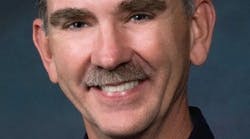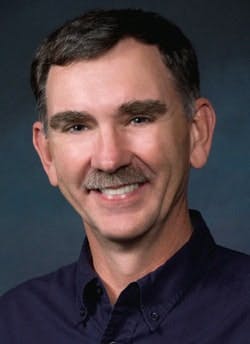Stan Moore, PE, CMRP, is currently the reliability and maintenance manager for Carpenter Technology in Athens, Alabama, where Carpenter is building a new state-of-the-art premium alloy facility. Moore has served on the SMRP board of directors since 2008 and will rotate off the board in October. He was SMRP chair in 2011-2012. During his tenure on the board, Moore worked for an integrated nylon 6,6 manufacturer, Ascend Performance Materials, a privately held company, as well as for Carpenter Technology.
PS What are the big changes you have seen in maintenance and reliability from when you were SMRP chair until now?
SM: Since I am still serving on the board, I will broaden my timeframe to include my total time on the board. From my vantage point, I see two key areas where change has been most evident. The first is technology and the second is culture. Taking advantage of new technologies is critical if one is to move the maintenance program from a time-based or worse, a reactive, state to a more condition-based reliability and maintenance strategy. The classical P-F curve, that most practitioners should be familiar with, illustrates the benefits of moving an organization from the more typical preventive program to a program that is more proactive
Some of the key technologies that support a proactive condition-based maintenance strategy include thermography, vibration analysis, and lubricant analysis, to name a few. While these technologies have been in use for some time, the hardware and software continue to be refined. For example, the use of wireless devices and the advance of apps for the various tablet platforms. Effective use of these tools is a great enabler necessary for an effective program.
The second area of change is cultural. The early adapters are those organizations that see the benefits and are leaders in driving change. Companies that have a reliable asset base often are those companies that have continuous improvement processes in place; they are continually involved in process improvements. They effectively use technologies to improve their asset reliability and they are unencumbered by tradition, willing to explore new opportunities that deliver value. In a broader sense, I also see more and more organizations taking advantage of the harmonized metrics developed by SMRP. These metrics are excellent tools by which organizations can gauge their current practices and support the development of action plans to drive improvements.
PS: What is the one accomplishment under your leadership that you are most proud of?
PS: Who in the SMRP organization has had the biggest influence on your career?
SM: Actually, I need to mention three gentlemen. All were involved in SMRP at various times during my tenure. The first is Butch DiMezzo. Butch has served in numerous capacities in support of SMRP, and he mentored me in the art and science of chairing the annual conference. I was his conference co-chair in 2007, which positioned me to be the conference chair in 2008. Butch easily shared his own knowledge and experiences, which allowed me to be successful in my role as conference chair. Butch brings a wealth of industry experience and professionalism to the board and his support of me is most appreciated. David Staat is the second mentor I want to acknowledge. David was on the board and also served as chair. David is the quintessential engineer, having worked for DuPont as a reliability consultant. His leadership and technical expertise served the organization well as the organization continued to grow. On a personal level, I found David to be a reliable resource, and I valued his inputs and suggestions. Bob DiStefano served on the board as we were forging our way forward with the formation of the SMRP Foundation, a 501(c)(3) organization. During this time period, the SMRP was reorganized into a 501(c)(6) society and a 501(c)(3) foundation. Bob's business acumen was very helpful to me, as treasurer, in the development of the independent operating budgets for both organizations. Additionally, his insight into the business side of reliability has been motivation for many including myself.
PS: Where is the maintenance and reliability profession headed, and where would you like to see it go?
SM: The primary challenge that continues to face this professional group is being able to clearly and objectively articulate the value and benefit of asset reliability, from cradle to grave. Most espouse to know the benefits of reliable assets; few know how to achieve and sustain cost effectively. There are many ways that the various stages of an asset's life are described. I divide them into four simple areas. They are design, installation, operation, and maintenance. I liken these four elements to four legs on a stool. Take away or weaken any one leg and the function of the stool — to reliably support you — is compromised. The desire for reliable assets should be as commonplace as the desire for zero injuries. Intuitively, we support that premise, but often there are seemingly competing priorities that threaten to derail. We, reliability and maintenance practitioners, often focus our communications internally rather than externally. While it is important to have the internal exchange of knowledge, it is equally important to communicate those benefits and successes in ways that generate interest and participation from our design, construction, and operation peers. Ultimately, cost is the key driver. That is an inescapable fact. We want assets designed, installed, operated, and maintained as cost-effectively as possible. The upfront capital cost, which usually includes the design and install elements of an asset's life, is as important as the ongoing operational and maintenance costs. Reliable and cost-effective design is paramount for the success of a project. Reliability and maintenance practitioners should be incorporated into the construction teams to highlight opportunities early in the asset's life that will improve reliability and reduce cost with minimal cost impact. The most basic and simple of influences during the design and install stages can have significant impact on the lifecycle costs of operating and maintaining the assets.
I believe that the SMRP will continue to lead the charge in driving and promoting excellence in reliability and maintenance. I would like to see more two-year and four-year college programs that place a primary emphasis on asset reliability, how to achieve it, and how to sustain it. Practitioners should continue to develop practices and methodologies that clearly communicate the benefits. I often use the analogy of a journey when talking about safety. With safety, it is a daily and conscious decision, I can work injury-free, but it requires focus and attention. Much like safety, reliability excellence also requires constant focus. Continuous improvement and wisely challenging past paradigms are necessary in this competitive and global market.

